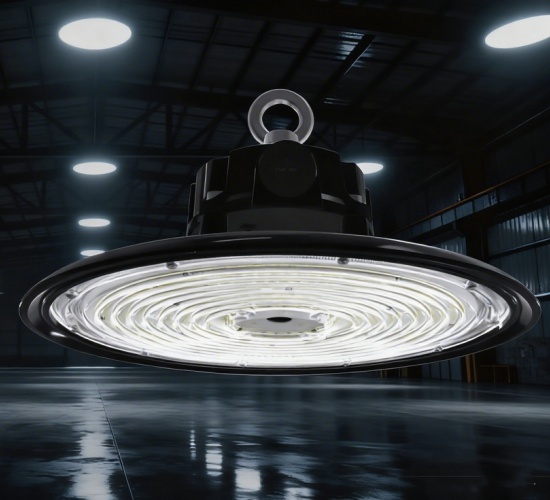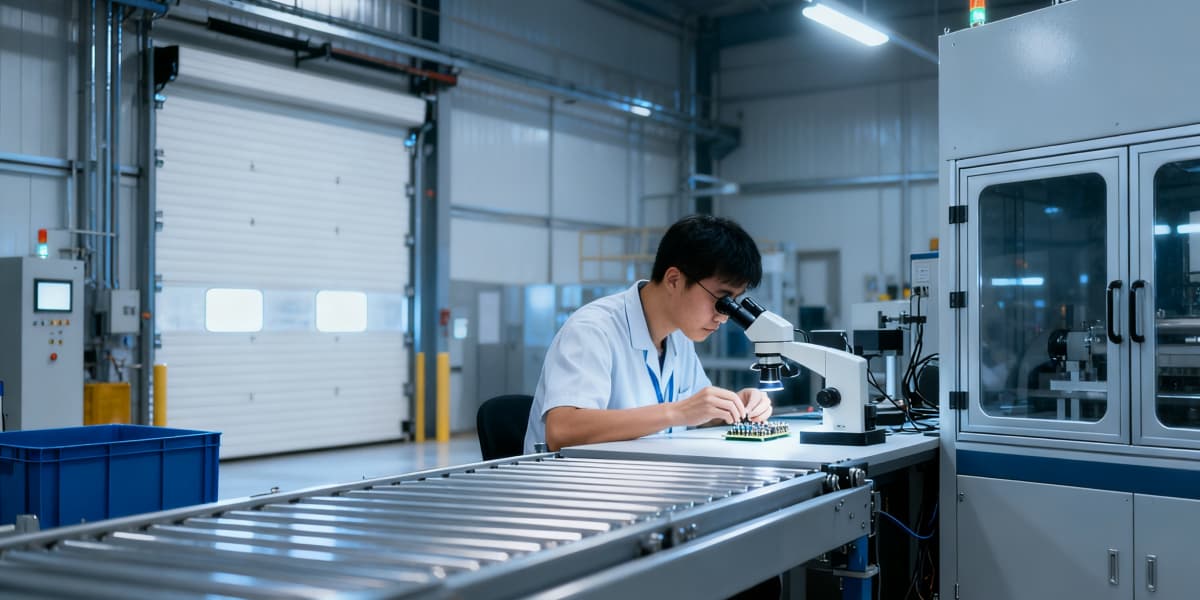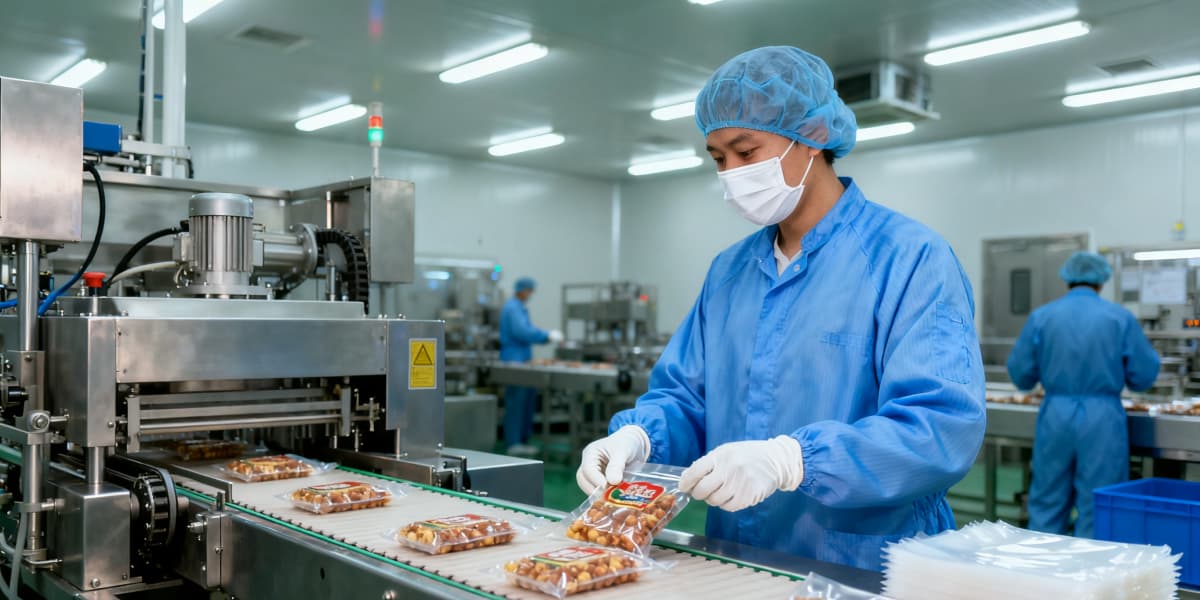LED工場照明:産業用ワークスペース照明ガイド

ディレクトリ:
LED 工場照明は現代の産業照明の基盤であり、生産施設、倉庫、作業場に強力な明るさ、長寿命、大幅なエネルギー節約をもたらします。
従来のメタルハライドランプや蛍光灯と比較して、LED 照明はより安全で、より効率的で、環境に優しい動作を保証します。
このガイドでは、適切な LED 工場用照明の選び方、その技術仕様の理解方法、そして LED への切り替えがあらゆる産業スペースにとって賢明な投資となる理由について説明します。
1. はじめに – 工場照明が重要な理由
工場の照明は単なる明るさをはるかに超え、産業環境全体の安全性、正確性、生産性の基盤として機能します。
大規模施設は、高層構造物、複雑な設備、そして高負荷機器を収容し、連続稼働していることがよくあります。このような空間では、精密な作業をサポートし、安全な環境を維持するために、安定した強力な照明が必要です。
LED工場照明の真価はここに あります。従来のHIDランプや蛍光灯と比較して、LEDはより明るい光を発しながら、消費電力を大幅に削減します。均一な光を発し、ちらつきを防ぎ、発熱も最小限に抑えながら、従来のシステムに比べて最大5倍の寿命を誇ります。
工場管理者にとって、これは電力コストの削減、メンテナンスのためのダウンタイムの短縮、生産フロア全体の照明の明るさ向上につながります。
持続可能性とパフォーマンスが中心となるにつれ、現代の製造施設では LED ベースのソリューションが好まれる選択肢となっています。
既存のセットアップをアップグレードする場合でも、新しいインストールを計画する場合でも、適切な LED 工場照明を選択すると、より安全で省エネで予算に優しい産業環境を作り出すことができます。
2. 工場環境における主な照明の課題
工場環境は照明システムにとって最も過酷な条件の一つです。高い天井、広い生産エリア、埃、湿気、熱などは、照明の性能と安全性に影響を与える可能性があります。また、多くの工場は24時間365日稼働しているため、照明器具は長時間の稼働でも頻繁に故障することなく動作する必要があります。
従来のメタルハライドランプや蛍光灯は、このような状況下ではしばしば問題を抱えます。始動に時間がかかり、時間の経過とともに明るさが低下し、頻繁に交換が必要になります。これらの弱点は、メンテナンスコストの増加につながるだけでなく、作業現場での視界不良や事故のリスクも高めます。
一方、LED工場用照明は、 こうした過酷な環境にも耐えられるよう設計されています。ちらつきのない安定した照明を提供し、色の均一性を維持し、高温や埃の多い環境でも効率的に動作します。IP65+の保護等級と高度な放熱性を備えたLED照明は、従来の照明器具では到底及ばない耐久性を備えています。
違いを説明するための簡単な比較を以下に示します。
特徴 | メタルハライド/蛍光 | LED工場用照明 |
起動時間 | ゆっくり(2~5分) | インスタントオン |
エネルギー効率 | 60~80 lm/W | 120~150 lm/W |
寿命 | 約10,000時間 | 5万~10万時間 |
メンテナンス | 電球とバラストの頻繁な交換 | 最小限のメンテナンス |
熱出力 | 高い | 低い |
明るさの減衰 | 1年後に顕著に現れる | 長年にわたって安定 |
このため、現代の工場のほとんどがフル LED 照明システムに移行しています。これにより、視認性と安全性が向上するだけでなく、エネルギーとメンテナンスの長期的な節約にもつながります。
次に、本当に高品質の LED 工場用ライトを定義する要素 と、購入前に注目すべき機能について詳しく見ていきましょう。
3 . 優れた LED 工場照明の条件とは?
工場向け高天井LED照明において、性能と信頼性は非常に重要です。優れた設計のLED工場照明は、広い空間を均一に照らすだけでなく、熱、埃、湿気といった過酷な作業環境にも耐えられる必要があります。
以下は、高品質の工場照明システムを定義する主要な技術的特徴です。
(1) 高発光効率(130 lm/W以上)
エネルギー効率は長期的な運用コストに直接影響します。最高の工場用LED照明は、1ワットあたり130ルーメン以上の明るさを実現し、より多くの電力を熱ではなく可視光に変換します。この高い効率は、より明るい照明とより低い電気代を意味し、24時間365日稼働する大規模施設にとって重要な利点となります。
(2) 高演色性(CRI≥80)
CRIが高いほど、 作業員は色や細部を正確に見ることができます。これは、組み立て、検査、品質管理の現場で特に重要です。演色性が低いと、視覚疲労を引き起こしたり、時間の経過とともに製造ミスにつながる可能性があります。最適な鮮明さと快適さを実現するには、CRI 80以上の工場用LED照明をお探しください。
(3) IP65+の保護と耐久性
産業環境では、埃、湿気、高温が伴うことがよくあります。最低でもIP65の保護等級 が必須であり、IP67またはIP69Kは噴流水や腐食に対する耐性を保証します。IK08の耐衝撃性を 備えた頑丈な筐体は、 偶発的な衝撃や振動からも保護します。
(4) アンチグレアと広角ビーム設計
適切なビーム分布は視認性を向上させ、グレアを軽減します。これは作業者の快適性と安全性にとって非常に重要です。天井高が6~15メートルの工場では、明るさと照射範囲のバランスをとるために、調整可能なビーム角度(60°、90°、または120°)を お選びください。アンチグレアレンズやディフューザーを使用することで、視覚的な快適性をさらに高めることができます。
(5) 長寿命と安定した出力
LEDシステムの総合的な価値は長寿命によって決まります。最高級の産業用LED照明は通常50,000時間以上持続しますが、プレミアムグレードのモデルでは100,000時間(L80B10)に達することもあります。これにより、交換頻度、人件費、ダウンタイムが大幅に削減されます。
(6) 例:セラミクライトHB01ハイベイLEDライト
例えば、CeramicliteのHB01 LEDハイベイライトは 、大規模な工場や倉庫向けに特別に設計されています。最高レベルの光学性能と産業グレードの耐久性を兼ね備えています。

発光効率: 160 lm/W (±5%)
入力電力: 60W / 80W / 100W
入力電圧: 90~240Vac
色温度: 3000K~6000K カスタマイズ可能
演色評価数: 70/80
保護: IP67 / IP69K、IK08
寿命: 102,000時間 (L80B10@35℃)
認証: CE、RoHS、UL、ETL
ちらつきのない設計、0 ~10V調光対応、そして堅牢なセラミックLEDモジュール により、連続使用における信頼性の高い産業用ソリューションを実現します。過酷な工場環境にも耐えうる設計のHB01は、高性能LED工場照明に求められる効率性、耐久性、そして精度を体現しています。
4 . 適切な LED 工場用照明を選ぶには?
工場に最適なLED照明を選ぶには、明るさだけでなく、工場の作業環境に適した照明性能を選ぶことが重要です。購入前に考慮すべき重要な要素をご紹介します。
ステップ1:天井の高さと作業エリアに合わせて明るさを調整する
工場のレイアウトはそれぞれ異なります。天井が高く、広いスペースには、より強いルーメン出力と狭いビーム角度が必要です。
高さ6~8m: 60~80W、ビーム角120°の照明器具
高さ9~12m: 90°ビーム角の100~150W照明器具
高さ13m以上: ビーム角60°の200W以上の照明器具
各作業区域が照度基準 (組立ラインでは通常300~500ルクス)を満たしていることを確認してください。照明が多すぎるとエネルギーが無駄になり、照明が少なすぎると作業の精度や安全性に影響が出る可能性があります。
Step 2: Check Environmental Resistance
Industrial LED light fixtures must survive tough conditions such as dust, moisture, heat, or vibration. Look for lights rated at least IP65, and ideally IP67 or IP69K for harsh environments like food processing or metal workshops.
If the area experiences strong vibrations or temperature fluctuations, choose fixtures with solid aluminum housing and anti-vibration mounting brackets.
Step 3: Prioritize Energy Efficiency and Safety Certifications
Efficiency and compliance go hand-in-hand. Always verify that the product meets UL, DLC, CE, or RoHS certifications.
These not only confirm safety and quality but may also qualify your project for energy rebates or government incentives. Opt for fixtures with Power Factor ≥ 0.9 and efficacy above 130 lm/W to ensure both performance and savings.
Step 4: Evaluate Warranty and After-Sales Support
Industrial lighting is a long-term investment. A reputable manufacturer should provide at least a 5–10 year warranty and professional technical support. Avoid low-cost, uncertified products that often fail early or lack replacement parts.
Check whether the supplier offers custom lighting design or on-site guidance for installation — this often reflects their reliability and commitment to customer satisfaction.
Step 5: Look for Smart Controls and Integration Options
Modern factories are adopting smart lighting systems that automatically adjust brightness based on occupancy or daylight. Choose fixtures compatible with:
0–10V / DALI dimming
Motion or daylight sensors
APP or centralized control systems
These intelligent functions reduce unnecessary power consumption and enhance worker comfort, especially in large-scale production areas.
Choosing the right LED factory lights ensures consistent brightness, lower operating costs, and safer working environments for years to come.
Ceramiclite provides professional-grade LED factory lighting with a 10-year warranty and full customization — designed to meet every industrial challenge with precision and reliability.
5. How to Plan Factory LED Lighting Layout?
A well-designed factory lighting layout ensures that every corner of the workspace is properly illuminated — improving visibility, productivity, and worker safety. Whether upgrading an old system or building from scratch, lighting design should be based on task requirements, ceiling height, and light distribution.

Electronic and Electrical Appliance Factories (AI-generated simulation image)
Step 1: Understand Illumination Standards
Before selecting or positioning fixtures, determine the proper brightness level (lux) for each area according to international standards such as EN12464-1 and OSHA guidelines:
Factory Area | Recommended Illuminance (Lux) | Description |
Assembly Line | 300–500 lux | Bright and uniform light for precision tasks |
Warehouse / Storage | 150–300 lux | Balanced brightness for navigation and safety |
Precision Inspection | 500–750 lux | High visibility for detailed work |
Packaging / Loading | 200–300 lux | Moderate lighting to reduce glare |
Aisles & Corridors | 100–200 lux | General visibility for movement |
Adequate lighting levels prevent eye strain and accidents while maintaining production accuracy.
Step 2: Calculate Mounting Height and Beam Angle
The mounting height directly affects how light spreads across the workspace:
6–8 meters: Use 120° beam angle for wide coverage.
9–12 meters: Use 90° beam angle to balance intensity and reach.
13+ meters: Use 60° beam angle to concentrate light on target areas.
A narrower beam concentrates light downward, ideal for tall ceilings, while a wider beam suits open-floor areas where even illumination is required.
Step 3: Optimize Fixture Spacing
To maintain uniformity, space fixtures evenly based on their beam angle and mounting height.
A practical rule of thumb is:
Spacing (S) ≈ 0.8 × Mounting Height (H)
For example, if fixtures are mounted at 10 meters, the ideal spacing between lights should be around 8 meters. This helps achieve balanced brightness without dark zones or excessive overlap.
Step 4: Consider Reflectance and Color Temperature
Reflective surfaces (white walls, bright flooring) increase light efficiency by up to 20%. Choosing the right color temperature (4000K–5000K) creates a neutral white tone that enhances visibility and alertness — ideal for production lines and assembly areas.
Step 5: Run Lighting Simulations or Pilot Tests
Before final installation, conduct a lighting simulation using software like DIALux or Relux. Simulations visualize how light spreads, identify potential shadow zones, and estimate total energy consumption.
Alternatively, install a sample fixture in each zone to compare brightness and coverage in real conditions before scaling up the design.
A well-planned factory lighting layout not only meets industry standards but also minimizes energy waste and maximizes visual comfort. By aligning fixture type, layout, and brightness with your factory’s workflow, you’ll achieve both safety and efficiency.
Next, we’ll look at real-world examples of how LED factory lights perform in different industrial environments.
6. Real-World Applications & Case Studies
Here are a few real-world examples that show how the right lighting design can dramatically improve productivity, safety, and energy efficiency.
Case 1: Automotive Manufacturing Plant – High Brightness & Uniform Coverage
In a car assembly workshop, workers perform detail-oriented tasks that demand excellent visibility. Ceramiclite’s HB01 high bay LED lights were installed at a height of 10 meters, delivering over 500 lux across the work area.
The result? A 45% energy reduction compared with the previous metal halide lamps, plus significantly better color accuracy for quality control. The uniform beam angles (90°/120°) helped eliminate shadows on assembly lines, improving workflow safety and precision.

Automotive Manufacturing Factories (AI-generated simulation image)
Case 2: Food Processing Factory – Hygienic, Moisture-Proof Design
A food packaging facility required lighting that could withstand frequent washdowns and meet hygiene standards. The IP69K protection of Ceramiclite HB01 made it an ideal fit — fully sealed against water, dust, and steam.
After upgrading from fluorescent fixtures, the factory achieved a 42% cut in power consumption and extended maintenance intervals from 6 months to over 5 years, thanks to the fixture’s 102,000-hour lifetime and anti-flicker technology compliant with ErP standards.
 Food Processing Factories (AI-generated simulation image)
Food Processing Factories (AI-generated simulation image)
Case 3: Logistics & Warehouse Center – Smart, Long-Hour Operation
In a 24/7 warehouse, energy management was key. The facility implemented HB01 lights with 0–10V dimming and motion sensors, automatically adjusting brightness based on occupancy and daylight. This system lowered operational costs by over 40% annually while maintaining consistent 300-lux illumination in key zones.
Key Takeaway
Across industries, Ceramiclite’s factory lighting solutions prove that well-designed LED systems can deliver measurable results — higher efficiency, lower costs, and safer working conditions.
Whether you run a precision assembly plant or a large warehouse, Ceramiclite helps you design, supply, and optimize the perfect LED lighting layout for your facility.
7. Conclusion
工場照明をLEDにアップグレードすることは、単に電球を交換するだけではありません。施設の働き方を変革することです。高性能LED照明は、強力な明るさ、最大60%の省エネ、最小限のメンテナンス、そして ちらつきのないグレア制御による安全性の向上を実現します。
スマートな調光機能とセンサーのオプションを備えた最新の LED システムは、リアルタイムのニーズにも適応し、無駄を削減し、使用される電力のワット数を最適化します。
Ceramiclite の工場照明ソリューションは、 産業用耐久性とインテリジェント制御を組み合わせ、メーカーがよりクリーンで安全、かつ生産性の高い環境を作り出すのに役立ちます。
Ceramiclite の産業用照明ソリューションが、より明るく、より安全で、より効率的な生産スペースの構築にどのように役立つかをご覧ください。
_thumb.jpg)